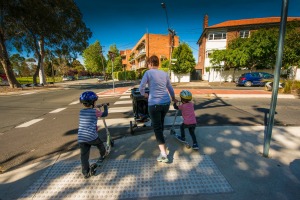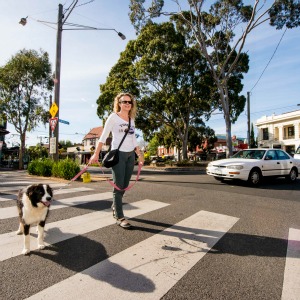Case Study - Port Phillip roundabout treatments
Roundabouts can be difficult to navigate for pedestrians as they have different rules to other intersections. Roundabouts are not conducive to pedestrian mobility as pedestrians must give way to all vehicles.
A study undertaken in Western Australia revealed that 54% of the pedestrians interviewed found the rules associated with roundabouts confusing and 72% found it harder to cross at a roundabout than at a conventional crossing (Browning 2001, cited in Candappa et al 2005).
Design

The City of Port Phillip, constructed an innovative treatment at a busy suburban roundabout designed to provide greater safety and convenience for pedestrians. The design provides right-of-way for pedestrians directly at the intersection as opposed to standard roundabout design.
The redesign of the roundabout involved the installation of raised pedestrian crossings, which are flush with the footpath, marked by zebra crossings. The existing bike lanes were removed and more pronounced line marking were introduced. These raised pedestrian crossings act as a slowing mechanism for approaching cars as they are given the feeling that they are crossings a pedestrian orientated zone.
Results

Since the treatment in 2005 there have been no crashes at the site. A survey of those who use the roundabout found that a significantly larger number of respondents believed the roundabout crossing was safe (24% before compared with 64% after), that travel speeds were more acceptable (47%, before and 66% after), and that more drivers were giving way to pedestrians in the after-period (78%) compared to before treatment (30%). 89% of respondents found the pedestrian crossings easy to use after treatment, compared with 54% before treatment. Similarly, there was a large increase in the proportion of pedestrians believing the waiting time was convenient after treatment, increasing from 15% to 76%. However, some respondents felt that drivers and pedestrians were confused as to who had right of way in the unconventional treatment.
The fact that drivers may not be sure what to do encourages them to reduce their speed and assess the situation as is the case in shared space zones. Slower vehicle speeds assist in protecting pedestrians from any driver that does not give way, while also having a general traffic calming effect. Moreover, in the event of a crash, lower speeds reduce pedestrian injury risk, the probability of fatal injury to a pedestrian reducing dramatically for reductions in impact speeds between 30 km/h and 50 km/h.
The results are detailed in the paper Evaluation of an Alternative Pedestrian Treatment at a Roundabout.